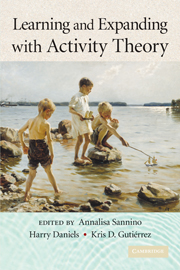Book contents
- Frontmatter
- Contents
- Contributors
- Editors' introduction
- 1 Activity Theory Between Historical Engagement and Future-Making Practice
- PART ONE UNITS OF ANALYSIS
- PART TWO MEDIATION AND DISCOURSE
- PART THREE EXPANSIVE LEARNING AND DEVELOPMENT
- 8 The Concept of Development in Cultural-Historical Activity Theory: Vertical and Horizontal
- 9 Two Theories of Organizational Knowledge Creation
- 10 Contradictions of High-Technology Capitalism and the Emergence of New Forms of Work
- 11 Spinozic Reconsiderations of the Concept of Activity: Politico-Affective Process and Discursive Practice in Transitive Learning
- PART FOUR SUBJECTIVITY, AGENCY, AND COMMUNITY
- PART FIVE INTERVENTIONS
- Bibliography
- Author Index
- Subject Index
9 - Two Theories of Organizational Knowledge Creation
Published online by Cambridge University Press: 05 June 2012
- Frontmatter
- Contents
- Contributors
- Editors' introduction
- 1 Activity Theory Between Historical Engagement and Future-Making Practice
- PART ONE UNITS OF ANALYSIS
- PART TWO MEDIATION AND DISCOURSE
- PART THREE EXPANSIVE LEARNING AND DEVELOPMENT
- 8 The Concept of Development in Cultural-Historical Activity Theory: Vertical and Horizontal
- 9 Two Theories of Organizational Knowledge Creation
- 10 Contradictions of High-Technology Capitalism and the Emergence of New Forms of Work
- 11 Spinozic Reconsiderations of the Concept of Activity: Politico-Affective Process and Discursive Practice in Transitive Learning
- PART FOUR SUBJECTIVITY, AGENCY, AND COMMUNITY
- PART FIVE INTERVENTIONS
- Bibliography
- Author Index
- Subject Index
Summary
LEARNING WHAT DOES NOT YET EXIST
In the mid-1990s knowledge management became an important area of business management studies (Swan, Robertson, & Bresnen, 2003). Ikuro Nonaka and Nobuko Takeuchi set the scene for much of the later discussion in their seminal book The Knowledge Creating Company (1995). The authors quote Herbert Simon's (1986) definition of the task of modern organization theory:
A major target for research in organisations today is to understand how organisations acquire new products, new methods of manufacture and marketing, and new organisational forms. This is the unfinished business that Chester Barnard left for us. (Nonaka & Takeuchi, 1995, p. 50)
According to Nonaka and Takeuchi, it is even more important to understand how organizations create the new knowledge that makes innovations possible.
After reviewing how knowledge creation has been dealt with in different traditions, they conclude:
Even though many of the new management theories since the mid-1980s have pointed out the importance of knowledge to society and organisations in the coming era, there are very few studies on how knowledge is created within and between business organisations. At the core concern of these theories is the acquisition, accumulation, and utilization of existing knowledge; they lack the perspective of creating new knowledge. (Nonaka & Takeuchi, 1995, p. 49)
Eight years earlier, Yrjö Engeström's book Learning by Expanding (1987) had been published, with the following blurb on the back cover:
Traditional learning theories regard learning as a process of acquisition and reorganisation of cognitive structures within the closed boundaries of given tasks or problem contexts. […]
- Type
- Chapter
- Information
- Learning and Expanding with Activity Theory , pp. 144 - 159Publisher: Cambridge University PressPrint publication year: 2009
- 9
- Cited by



